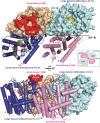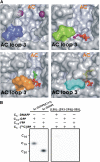Structure of a heterotetrameric geranyl pyrophosphate synthase from mint (Mentha piperita) reveals intersubunit regulation
- PMID: 20139160
- PMCID: PMC2845413
- DOI: 10.1105/tpc.109.071738
Structure of a heterotetrameric geranyl pyrophosphate synthase from mint (Mentha piperita) reveals intersubunit regulation
Abstract
Terpenes (isoprenoids), derived from isoprenyl pyrophosphates, are versatile natural compounds that act as metabolism mediators, plant volatiles, and ecological communicators. Divergent evolution of homomeric prenyltransferases (PTSs) has allowed PTSs to optimize their active-site pockets to achieve catalytic fidelity and diversity. Little is known about heteromeric PTSs, particularly the mechanisms regulating formation of specific products. Here, we report the crystal structure of the (LSU . SSU)(2)-type (LSU/SSU = large/small subunit) heterotetrameric geranyl pyrophosphate synthase (GPPS) from mint (Mentha piperita). The LSU and SSU of mint GPPS are responsible for catalysis and regulation, respectively, and this SSU lacks the essential catalytic amino acid residues found in LSU and other PTSs. Whereas no activity was detected for individually expressed LSU or SSU, the intact (LSU . SSU)(2) tetramer produced not only C(10)-GPP at the beginning of the reaction but also C(20)-GGPP (geranylgeranyl pyrophosphate) at longer reaction times. The activity for synthesizing C(10)-GPP and C(20)-GGPP, but not C(15)-farnesyl pyrophosphate, reflects a conserved active-site structure of the LSU and the closely related mustard (Sinapis alba) homodimeric GGPPS. Furthermore, using a genetic complementation system, we showed that no C(20)-GGPP is produced by the mint GPPS in vivo. Presumably through protein-protein interactions, the SSU remodels the active-site cavity of LSU for synthesizing C(10)-GPP, the precursor of volatile C(10)-monoterpenes.
Figures





Similar articles
-
Enhanced specificity of mint geranyl pyrophosphate synthase by modifying the R-loop interactions.J Mol Biol. 2010 Dec 17;404(5):859-73. doi: 10.1016/j.jmb.2010.10.011. Epub 2010 Oct 19. J Mol Biol. 2010. PMID: 20965200
-
Formation of monoterpenes in Antirrhinum majus and Clarkia breweri flowers involves heterodimeric geranyl diphosphate synthases.Plant Cell. 2004 Apr;16(4):977-92. doi: 10.1105/tpc.020156. Epub 2004 Mar 18. Plant Cell. 2004. PMID: 15031409 Free PMC article.
-
Heteromeric and homomeric geranyl diphosphate synthases from Catharanthus roseus and their role in monoterpene indole alkaloid biosynthesis.Mol Plant. 2013 Sep;6(5):1531-49. doi: 10.1093/mp/sst058. Epub 2013 Mar 29. Mol Plant. 2013. PMID: 23543438
-
Structure, mechanism and function of prenyltransferases.Eur J Biochem. 2002 Jul;269(14):3339-54. doi: 10.1046/j.1432-1033.2002.03014.x. Eur J Biochem. 2002. PMID: 12135472 Review.
-
Agrobiological Interactions of Essential Oils of Two Menthol Mints: Mentha piperita and Mentha arvensis.Molecules. 2019 Dec 23;25(1):59. doi: 10.3390/molecules25010059. Molecules. 2019. PMID: 31878007 Free PMC article. Review.
Cited by
-
Terpene Specialized Metabolism in Arabidopsis thaliana.Arabidopsis Book. 2011;9:e0143. doi: 10.1199/tab.0143. Epub 2011 Apr 6. Arabidopsis Book. 2011. PMID: 22303268 Free PMC article.
-
A cytosolic bifunctional geranyl/farnesyl diphosphate synthase provides MVA-derived GPP for geraniol biosynthesis in rose flowers.Proc Natl Acad Sci U S A. 2023 May 9;120(19):e2221440120. doi: 10.1073/pnas.2221440120. Epub 2023 May 1. Proc Natl Acad Sci U S A. 2023. PMID: 37126706 Free PMC article.
-
Multi-domain terpenoid cyclase architecture and prospects for proximity in bifunctional catalysis.Curr Opin Struct Biol. 2016 Dec;41:27-37. doi: 10.1016/j.sbi.2016.05.010. Epub 2016 Jun 7. Curr Opin Struct Biol. 2016. PMID: 27285057 Free PMC article. Review.
-
Exploring AlphaFold2's Performance on Predicting Amino Acid Side-Chain Conformations and Its Utility in Crystal Structure Determination of B318L Protein.Int J Mol Sci. 2023 Feb 1;24(3):2740. doi: 10.3390/ijms24032740. Int J Mol Sci. 2023. PMID: 36769074 Free PMC article.
-
Isoprenyl diphosphate synthases: the chain length determining step in terpene biosynthesis.Planta. 2019 Jan;249(1):9-20. doi: 10.1007/s00425-018-3052-1. Epub 2018 Nov 22. Planta. 2019. PMID: 30467632 Review.
References
-
- Artz J.D., Dunford J.E., Arrowood M.J., Dong A., Chruszcz M., Kavanagh K.L., Minor W., Russell R.G., Ebetino F.H., Oppermann U., Hui R. (2008). Targeting a uniquely nonspecific prenyl synthase with bisphosphonates to combat cryptosporidiosis. Chem. Biol. 15: 1296–1306 - PubMed
-
- Brunger A.T. (1993). Assessment of phase accuracy by cross validation: The free R value. Methods and applications. Acta Crystallogr. D Biol. Crystallogr. 49: 24–36 - PubMed
-
- Brunger A.T., et al. (1998). Crystallography & NMR system: A new software suite for macromolecular structure determination. Acta Crystallogr. D Biol. Crystallogr. 54: 905–921 - PubMed
-
- Burke C., Croteau R. (2002). Interaction with the small subunit of geranyl diphosphate synthase modifies the chain length specificity of geranylgeranyl diphosphate synthase to produce geranyl diphosphate. J. Biol. Chem. 277: 3141–3149 - PubMed
-
- Burke C., Klettke K., Croteau R. (2004). Heteromeric geranyl diphosphate synthase from mint: construction of a functional fusion protein and inhibition by bisphosphonate substrate analogs. Arch. Biochem. Biophys. 422: 52–60 - PubMed
Publication types
MeSH terms
Substances
LinkOut - more resources
Full Text Sources
Other Literature Sources
Miscellaneous

